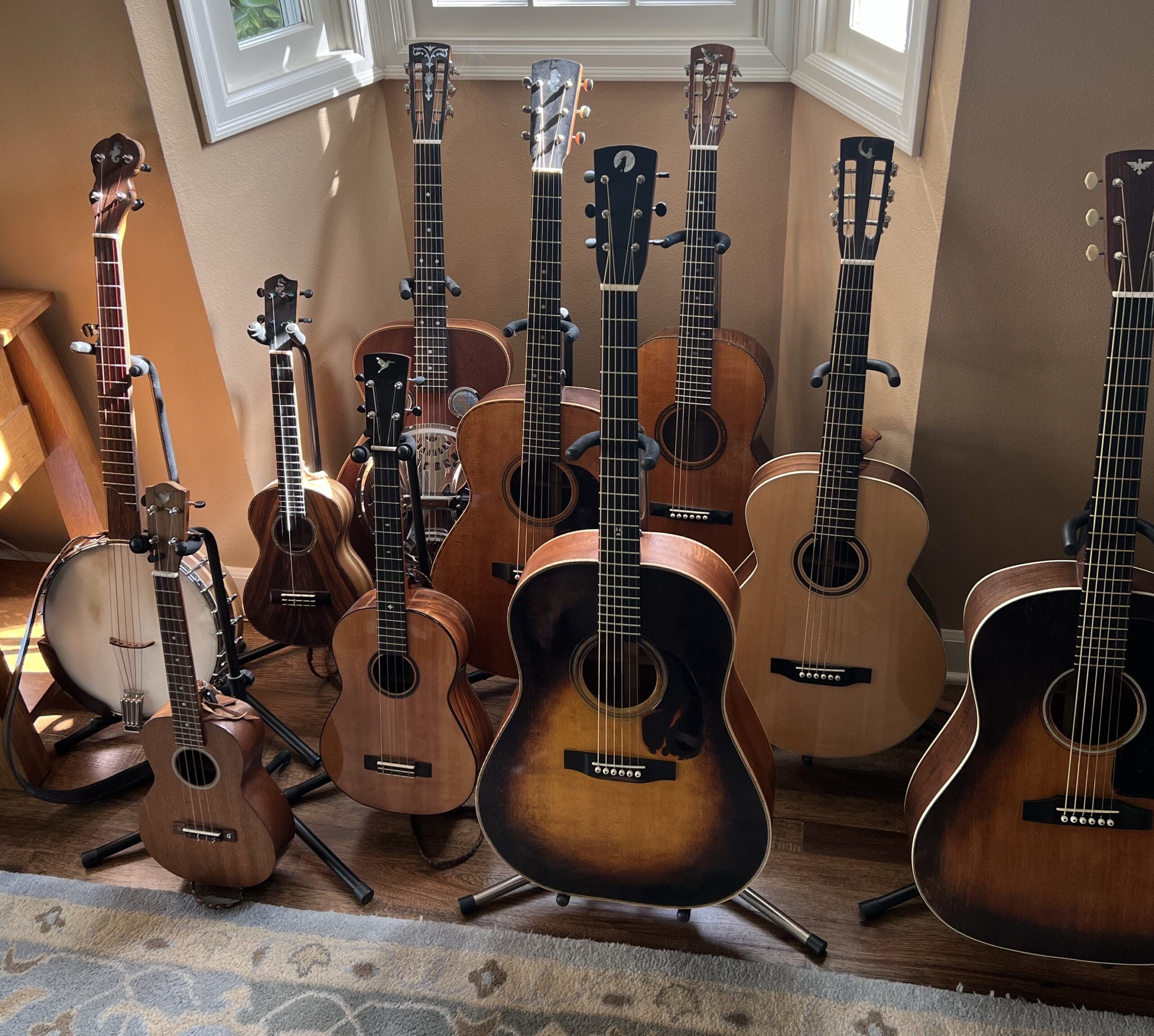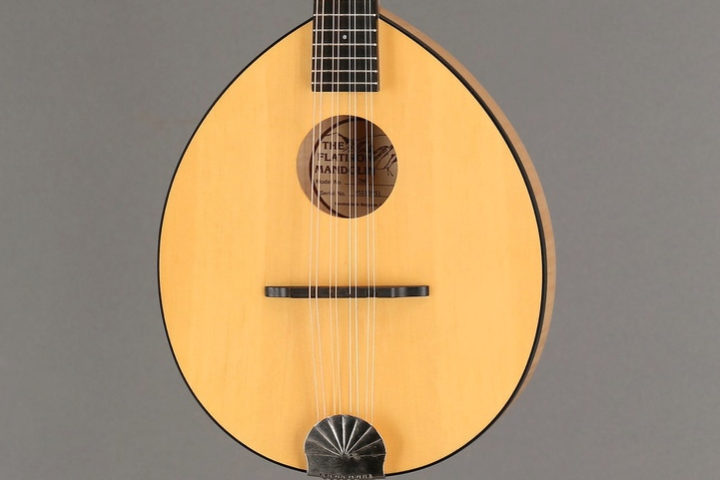Dan Wetzel is an anomaly. While there are droves of instrument makers who started out as aspiring musicians, Wetzel has managed to be both a maker and a touring musician. The Oregon-based guitarist/luthier plays alongside his wife in the award-winning Americana band, Kristen Grainger & True North. When he’s off the road, he’s quietly building fretted instruments for himself, friends and fans at his home workshop. He’s up to over two dozen instruments and he makes a habit of not repeating a model more than once.
As Wetzel tells us, he’s had a hand in instrument building for decades and was one of the first employees at Montana’s now-defunct Flatiron mandolin factory. After that job, he took a long break to pursue school and a career, but the instrument bug returned. He eventually purchased the Irving Sloane book on guitarmaking, set up a shop, and has been busy ever since.
Kristen Grainger & True North’s new album, Fear of Falling Stars, is out November 10. On the album, Wetzel built all the instruments he plays.
The Fretboard Journal is proud to premiere “The Avalanche” from the new album.
Fretboard Journal: We talk to a lot of musicians and a lot of luthiers. It is rare to find someone both building instruments and working as a touring musician.
Dan Wetzel: Both of those things have been a love of mine for a while, so it’s nice to combine them.
FJ: What came first, music or building guitars?
DW: Music. I started as a budding musician when I lived in Montana and got a job in a little shop there, Flatiron Mandolins, back when it was four or five people. I wasn’t a mandolin player, but I was a guitar player and quickly got hooked by the bug of building instruments. Then, I learned to play mandolin after that. That was a great experience working at Flatiron, but we all had our one little job, we were part of a production thing. Later on, after years of continuing to play music, I set up some space and started to build my own instruments from scratch. It’s just really been great.
FJ: When you went to work for Flatiron, were they only building those Gibson Army-Navy-style pancake mandolins?
DW: It was in the early ’80s. A guy named Chuck Morrison was building these Army-Navy mandolins based on an old Gibson model. He was selling them at NAMM shows. Steve Carlson, the guy who owned the music store in Bozeman, went to NAMM and said, “How many do you have? I’ll buy them all!” He eventually talked Chuck into moving to Bozeman and setting up a shop to build for him so that he could distribute them. It started with the little flat ones with the round hole. Then we started building mandolas and octave mandolins in the same pattern…and then we built a carving machine to start assimilating carved tops and F holes. Later, after I’d left, Gibson entered the picture and bought the company and it got really large.
FJ: What was your main job when you were working at Flatiron?
DW: Where I started, Chuck was getting ready to move back to Vermont. He had sold the business to Steve and said, “I’m going to train you to spray all the lacquer.” There was one guy already building all the necks and another guy building bodies and another person doing setup. So I would spray lacquer and then I learned to do the tinting. I would wet sand and buff out countless hours of instruments. It was kind of neat. I was there to gain residency and go back to college. Even after I went back to school, I would take home 15 mandolins on Fridays and wet sand and buff them out in my apartment and then bring them back and do the final buffing and take the next batch home.
FJ: Did you have much woodworking finish experience when you got this job?
DW: Very little. Just high school wood shop. My dad had always been a, “Let me see if I can fix this myself,” kind of guy, as was my grandpa. So it was something I was always around…
FJ: At what point did you decide to build yourself an instrument from start-to-finish?
DW: It was only about maybe 15 years ago. The first thing I built was a banjo. It was an all-wood banjo, not a brass-tone ring thing. And I built it because I was just interested in kind of a folky sound for a banjo, especially in our band. I built that first and we put it on our record right away. And then on this last album, I played it on a couple of songs. But to answer your question, [it was] when I lived in a home big enough to have space for a shop so I wasn’t trying to do it at the dining room table.
I was able to start to assemble a tool collection and build jigs so that I could repeat a process and make it accurate. That was one of the biggest skills I learned at Flatiron. I started to really assimilate that way of thinking, and then it became kind of an obsession…how could I do this a better way?
FJ: And that encourages you to make more than one of the same instrument, right?
DW: That’s right. In my case, I haven’t built the same guitar twice with one exception. I built these jigs that were adjustable so that I could use them for all shapes and sizes so that if somebody came and said, “Well, I want an OM shape, only thicker,” I can adjust my jig.
FJ: You first built an open-back banjo. What came next?
DW: I built a ukulele for Kristen as a surprise Christmas present because she had just taken up the ukulele. And then a guitar that I play today was my third. So I kind of went banjo, uke, guitar, and then it’s continued to go from there.
FJ: I’ve seen photos of you with the sunburst guitar. What did you base that on?
DW: A Gibson J-45. It’s a big slope shoulder guitar, but I use more of a modified Martin bracing pattern and more of a Martin neck shape-wise. And then the scale is longer so I can really dig into it when I’m flatpicking and it doesn’t wash out. Old Gibson’s have this great woody sound, but I love old Martins. I thought, how can I combine these two things?
FJ: At this point, how much of your life has been taken over by lutherie? Are you in the workshop all the time?
DW: It really goes in waves. We’ll be out playing gigs. We just launched this new album, so we’ve been playing a lot of shows. We’ve been on the road, so I’m hardly in the shop at all. And then we’ll come home and we have a down week. So I’m sitting in the shop right now and when we hang up, I’ve got a guitar I’m building for a client that I’m going to finish it up. When I’m home, I’m in the shop quite a bit just because it’s just so fun.
Some of Dan’s creations…

